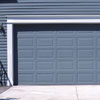Garage Door Materials
Is your garage door sagging and cracking, almost impossible to lift, or just generally falling apart? Perhaps it's time to replace it with a new one that's easy to operate and maintain. Not only can a new garage door provide safe, secure, easy access to your garage; it can renew and refresh your home's appearance.
 Two kinds of garage doors are available: tilt-ups and sectional
roll-up doors. The tilt-up type is a single panel that pivots out and up. A sectional roll-up door is made of four or more horizontal sections, hinged together and mounted with rollers to tracks at each side so the door can roll straight up and back.
Two kinds of garage doors are available: tilt-ups and sectional
roll-up doors. The tilt-up type is a single panel that pivots out and up. A sectional roll-up door is made of four or more horizontal sections, hinged together and mounted with rollers to tracks at each side so the door can roll straight up and back.
Though most tilt-up doors cost less than their sectional counterparts, a sectional door is generally favored because it's safer and easier to operate, can be opened even when a car is parked directly in front of it, and allows more headroom in the garage. Garage doors can be made from wood, steel, aluminum and fiberglass. Though each of these has its benefits, wood and steel garage doors are by far the favorites.
Wood is preferred more for its appearance and affordability than for its durability. Because wood expands and contracts and can warp or crack as it weathers, it demands regular maintenance repainting or refinishing every couple of years.
Steel garage doors are stronger and more secure than wood, aluminum, or fiberglass doors. Thanks to new technologies, today's steel doors rival the look of wood without the maintenance.
Aluminum garage doors have enjoyed many of the same design advances as steel. Aluminum single-piece, tilt-up doors are fairly popular because they are extremely lightweight, will not rust and are relatively inexpensive.
Fiberglass doors actually have an aluminum frame with fiberglass sections. Like aluminum, fiberglass is lightweight. Other advantages of fiberglass are resistance to salt air corrosion and translucency.
-- Tips courtesy of HomeAdvisor.com